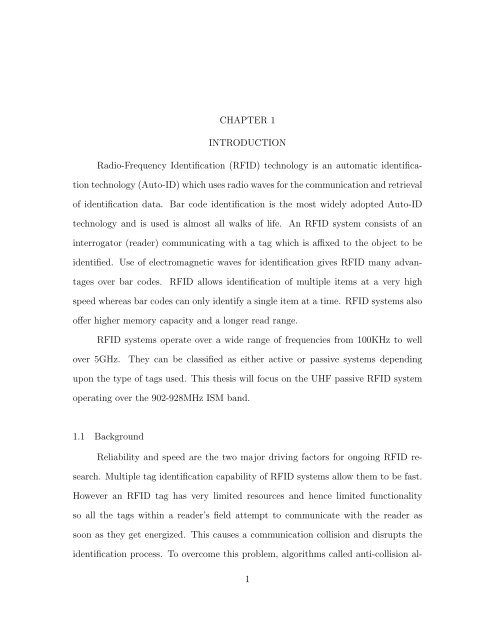utilizing physical layer information to improve rfid tag
utilizing physical layer information to improve rfid tag
utilizing physical layer information to improve rfid tag
Create successful ePaper yourself
Turn your PDF publications into a flip-book with our unique Google optimized e-Paper software.
CHAPTER 1<br />
INTRODUCTION<br />
Radio-Frequency Identification (RFID) technology is an au<strong>to</strong>matic identifica-<br />
tion technology (Au<strong>to</strong>-ID) which uses radio waves for the communication and retrieval<br />
of identification data. Bar code identification is the most widely adopted Au<strong>to</strong>-ID<br />
technology and is used is almost all walks of life. An RFID system consists of an<br />
interroga<strong>to</strong>r (reader) communicating with a <strong>tag</strong> which is affixed <strong>to</strong> the object <strong>to</strong> be<br />
identified. Use of electromagnetic waves for identification gives RFID many advan-<br />
<strong>tag</strong>es over bar codes. RFID allows identification of multiple items at a very high<br />
speed whereas bar codes can only identify a single item at a time. RFID systems also<br />
offer higher memory capacity and a longer read range.<br />
RFID systems operate over a wide range of frequencies from 100KHz <strong>to</strong> well<br />
over 5GHz. They can be classified as either active or passive systems depending<br />
upon the type of <strong>tag</strong>s used. This thesis will focus on the UHF passive RFID system<br />
operating over the 902-928MHz ISM band.<br />
1.1 Background<br />
Reliability and speed are the two major driving fac<strong>to</strong>rs for ongoing RFID re-<br />
search. Multiple <strong>tag</strong> identification capability of RFID systems allow them <strong>to</strong> be fast.<br />
However an RFID <strong>tag</strong> has very limited resources and hence limited functionality<br />
so all the <strong>tag</strong>s within a reader’s field attempt <strong>to</strong> communicate with the reader as<br />
soon as they get energized. This causes a communication collision and disrupts the<br />
identification process. To overcome this problem, algorithms called anti-collision al-<br />
1
















